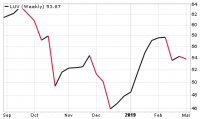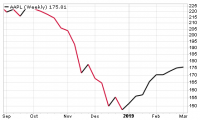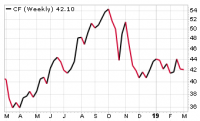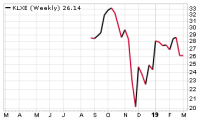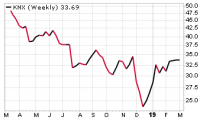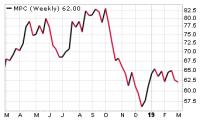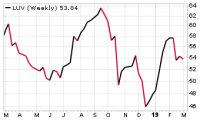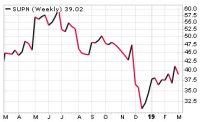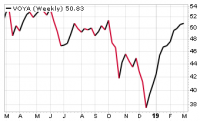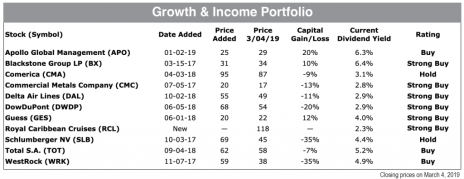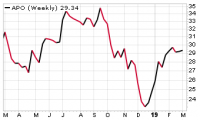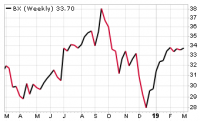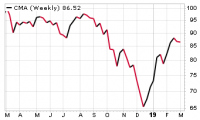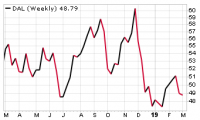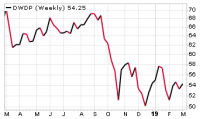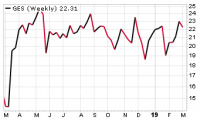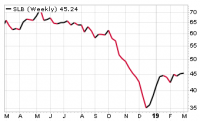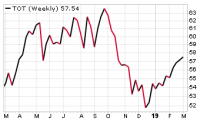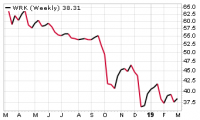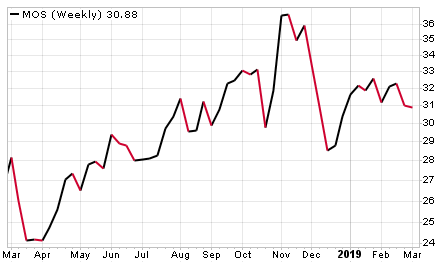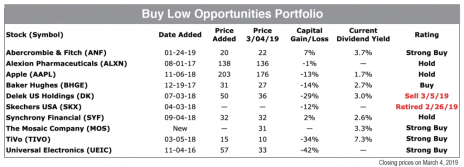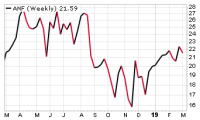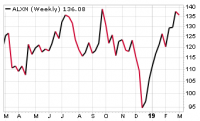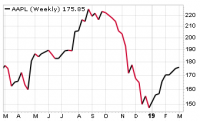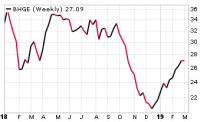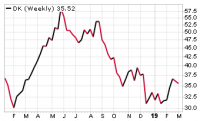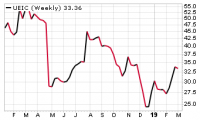If you own small or regional Western U.S. energy stocks, make sure to read my comments in the introduction about some pending legislation in Colorado that does not bode well for in-state energy production. I’m sorry to say that the legislation is likely to rapidly move through the legislature, because the minority political party does not have enough votes to block it, and the Governor is likely to sign it. For stock investors, forewarned is forearmed.
Cabot Undervalued Stocks Advisor 319
[premium_html_toc post_id="172198"]
The Calm Before the Next Market Run-Up
I suppose it makes sense that a calendar quarter that was characterized by two big stock market downdrafts could be followed by a calendar quarter that delivers two stock market run-ups. And while I anticipated and frequently wrote about my expectation for stocks to rebound in January, I’ve been surprised at their degree of strength. Pullbacks would have been normal following stock price run-ups in January. I still expect that an S&P 500 pullback to 2,625 could easily happen, which would merely represent a repetition of the index’s October/November 2018 trading range. The price chart on Southwest Airlines (LUV) beautifully illustrates an orderly February pullback after a strong January run-up.
Instead of pullbacks, we’ve had lots of stocks that simply rested, trading in narrow ranges that appear similar to horizontal lines on their price charts. If you want to see a visual, look here at the price chart on Apple (AAPL), which traded relatively flat in February. AAPL now appears to be starting its next run-up, as we saw recently with Supernus Pharmaceuticals (SUPN).
You can see a similar flattish trading pattern with Apollo Global Management (APO), Blackstone Group (BX), CIT Group (CIT), Comerica (CMA), Knight Swift Transportation (KNX) and Schlumberger (SLB).
This flat/sideways trading pattern usually means that a stock is resting prior to its next run-up, and that there’s enough buying strength to prevent it from having a pullback. While there’s no guarantee that a stock with a narrow trading pattern will subsequently rise, it certainly puts a smile on my face when I see that pattern in a stock that I favor. You can see a similar trading pattern if you scroll down to our featured stock in the Growth & Income Portfolio, Royal Caribbean Cruises (RCL), which joins the portfolio today as a Strong Buy.
Slower Earnings Growth
Another trend I’m noticing is that U.S. companies are projected for slower earnings growth in 2019 than in 2018. Whereas it was easy to find companies with 15%+ earnings per share (EPS) growth last year, many of those same companies are projected for EPS growth in the 10% area in 2019. (This is a broad generalization, of course, indicative of a trend. Individual company results will vary.) I don’t see this trend as problematic. Rather, I see it as economic growth returning to a norm, whereas last year’s growth was somewhat eye-popping.
Energy Trouble in Colorado
I am concerned enough about pending oil & gas legislation in Colorado – which is almost guaranteed to pass, since the Colorado legislature and Governorship are 100% controlled by the political party that introduced the legislation – to warn investors that share prices of companies with energy activity in Colorado are likely to suffer. Unfortunately, the news could be dire to some Colorado-focused energy companies, resulting in layoffs and possibly even business closures. Take the time to review your energy stocks. Go to the companies’ websites, where you can oftentimes find maps that detail areas where E&P companies drill and oilfield service companies work. If you decide to keep such stocks, I urge you to use stop-loss orders to protect your downside.
Send questions and comments to Crista@CabotWealth.com.
Portfolio Notes
Be sure to review the Special Bulletins from February 27, 28 and March 1 in which I mentioned news, rating changes and/or price action on Abercrombie & Fitch (ANF), Alexion Pharmaceuticals (ALXN), Guess? (GES), KLX Energy Services (KLXE), Southwest Airlines (LUV), Supernus Pharmaceuticals (SUPN) and TiVo (TIVO).
Final Earnings Season Scorecard
About half our stocks that report quarterly results ended up far exceeding analysts’ estimates. This is a phenomenon that can occur during bearish market cycles, when investors and Wall Street dial back their performance expectations. We could witness this situation in reverse if earnings season takes place right after a major market top.
Big earnings beat: Alexion Pharmaceuticals (ALXN), CIT Group (CIT), Commercial Metals (CMC), Delek U.S. Holdings (DK), Knight-Swift Transportation (KNX), Marathon Petroleum (MPC), Quanta Services (PWR), Skechers (SKX), Southwest Airlines (LUV), Supernus Pharmaceuticals (SUPN), Synchrony Financial (SYF), SYNNEX (SNX), Voya Financial (VOYA) and WestRock (WRK).
Earnings within 5% of consensus estimate: Apple (AAPL), BB&T Corp. (BBT), Baker Hughes (BHGE), Blackstone Group (BX), Comerica (CMA), Delta Air Lines (DAL), DowDuPont (DWDP), D.R. Horton (DHI), Regions Financial (RF) and Schlumberger (SLB).
Big earnings miss: Apollo Global Management (APO), CF Industries (CF), Martin Marietta (MLM), TiVo (TIVO), Total SA (TOT) and Universal Electronics (UEIC).
Buy-Rated Stocks Most Likely* to Rise More than 5% Near-Term
Abercrombie & Fitch (ANF)
Total SA (TOT)
*I can review price charts and make an educated determination about what’s likely to occur, but I will sometimes be wrong. I cannot control the stock market; I can only guide you through it.
Today’s Portfolio Changes:
Blackstone Group LP (BX) moves from Buy to Strong Buy.
Delek U.S. Holdings (DK) moves from Hold to Sell.
The Mosaic Company (MOS) joins the Buy Low Opportunities Portfolio as a Strong Buy.
Royal Caribbean Cruises (RCL) joins the Growth & Income Portfolio as a Strong Buy.
Sanmina Corp. (SANM) joins the Growth Portfolio as a Strong Buy.
Last Week’s Portfolio Changes:
Alexion Pharmaceuticals (ALXN) moved from Buy to Hold.
Skechers (SKX) moved from Hold to Retired.**
Southwest Airlines (LUV) moved from Hold to Strong Buy.
Total SA (TOT) moved from Hold to Buy.
Growth Portfolio
Growth Portfolio stocks have bullish charts, strong projected earnings growth, little or no dividends, low-to-moderate P/Es (price/earnings ratios) and low-to-moderate debt levels.
Featured Stock: Sanmina Corp. (SANM)
Sanmina Corp. joins the Growth Stock Portfolio today. Sanmina designs and manufactures optical, electronic and mechanical products for original equipment manufacturers (OEMs) in a broad variety of industries. The company operates through two businesses: Integrated Manufacturing Solutions (IMS) and Components, Products and Services (CPS). Sanmina has dozens of production facilities in 25 countries on six continents.
Sanmina has been growing revenue annually, reaching $7.1 billion in 2018. Earnings per share are expected to grow 36.7% and 12.3% in 2019 and 2020 (September year end). The 2019 P/E is quite low at 10.5.
SANM is a small-cap stock in the electronic equipment, instruments & components industry within the information technology sector. A high percentage of the outstanding shares are held by financial institutions. The outstanding share count has dropped by 15.7% over the recent four years through fiscal year-end 2018.
The stock rose as high as 42 in 2017, so that’s probably your maximum 2019 price target, giving new investors a potential 32% capital gain. SANM is currently resting after a January run-up. Short term, SANM could easily trade anywhere between 28-36, although I expect more of a 31-33 range, barring market disruptions or bad news. This stock is appropriate for risk-tolerant aggressive growth investors. Buy SANM now. Strong Buy.
Updates on Growth Portfolio Stocks
CF Industries Holdings (CF – yield 2.8%) is one of the world’s largest producers of nitrogen products, serving customers on six continents. The company operates nine nitrogen production facilities in Canada, the U.K. and the U.S. Investors may listen to the February 28 webcast of CF’s presentation at the Bank of America Merrill Lynch 2019 Global Agriculture and Materials Conference.
CF is a cyclical mid-cap stock, affected by both currencies and natural gas prices (lower prices being optimal). The company is expected to grow EPS by 92% and 27% in 2019 and 2020, with corresponding P/Es of 17.7 and 13.9. When CF surpasses 45, that could signal a new run-up. Buy CF now. Strong Buy.
CIT Group (CIT – yield 2.7%) operates both a bank holding company and a financial holding company that provide financing, leasing and advisory services to small and middle market businesses, consumer markets, and the real estate and railroad industries. The Equipment Leasing and Finance Association’s (ELFA) Monthly Leasing and Finance Index rose 4% year-over-year in January, reflecting strong U.S. economic activity.
CIT is an undervalued growth stock with an attractive dividend yield. Earnings per share are expected to rise 19.1% and 13.1% in 2019 and 2020. The 2019 P/E is 10.7. The company plans to increase the second quarter dividend by 40% to $0.35 per share, subject to approval by their Board of Directors. Based on the current share price of $50.77, the new dividend yield will be 2.7%.
CIT rose 44% from its December low through mid-February, and is now trading in a flat line on the price chart, which is a bullish chart pattern. A shakeout chart pattern could easily occur. A good illustration can be found within the February price chart of American International Group (AIG). If we get a shakeout, I’ll consider moving CIT to a Buy recommendation. Barring a takeover offer, the maximum near-term upside is 55, where the stock maxed out repeatedly in 2018. Hold.
D.R. Horton (DHI – yield 1.5%) — Hold.* (last report February 19)
KLX Energy Services (KLXE) will report fourth-quarter 2018 results on the morning of March 12 (January year end). Expect volatility. KLXE is an undervalued microcap stock that joined the portfolio in 2018 as a spin-off from KLX Inc. (KLXI). KLXE had a pullback amid an uptrend last week. Hold.
Knight-Swift Transportation Holdings (KNX – yield 0.7%) is the largest full truckload carrier in North America and an industry leader with an exemplary management team. The stock is fairly valued now that earnings growth is slowing. KNX rose about 44% from its December low through mid-February. The price chart appears bullish, with KNX trading in a flat line near 34. There’s price resistance at about 38. Hold.
Marathon Petroleum (MPC – yield 3.5%) is a leading integrated downstream energy company and the nation›s largest energy refiner, with 16 refineries, majority interests in two midstream companies, 10,000 miles of oil pipelines and product sales in 11,700 retail stores. Consensus earnings estimates reflect slow 2019 growth followed by a huge jump in 2020 EPS. The 2019 P/E is 9.8. MPC is trading steadily between 61-67 thus far in 2019. Buy MPC now. Strong Buy.
Martin Marietta Materials (MLM – yield 1.0%) is a supplier of stone, sand, gravel, cement, concrete and asphalt. The company foresees a continuing growth trajectory, fueled by strong demand from residential, non-residential and public projects.
Consensus estimates now point toward EPS growth rates of 21.5% and 17.9% in 2019 and 2020. The 2019 P/E is 21.3. MLM is a good investment for traders who have a two-to-six-month time frame, and long-term growth stock investors who want to own top-notch companies. Buy.
Quanta Services (PWR – yield 0.4%) provides specialized infrastructure and network services to the electric power, oil and natural gas industries. PWR is an undervalued mid-cap growth stock. The 2019 consensus EPS estimate is $3.32, but Quanta told analysts that they expect 2019 EPS within a range of $3.30-$3.75. Therefore, either more analysts will be publishing reports in which they raise their EPS estimates (which could cause investors to buy the stock) or the market will experience upside earnings surprises as quarterly results are released (which could also cause investors to buy the stock). I would caution, however, that PWR is getting close to some significant price resistance at 40. The stock could get stuck there for a while. Strong Buy.
Southwest Airlines (LUV – yield 1.2%) is the largest U.S. domestic air carrier, transporting over 120 million customers annually to over 100 locations in the U.S., Central America and the Caribbean. LUV is an undervalued growth stock. Last week, the company received FAA approval to begin service to Hawaii; filed a lawsuit against its mechanics union; and was the subject of rumors that Berkshire Hathaway (BRK/A) might want to purchase the airline. LUV is an undervalued growth stock. Wall Street expects EPS to increase 21.0% in 2019, and the P/E is 10.6. The near-term trading range looks to be about 53-59. Strong Buy.
Supernus Pharmaceuticals (SUPN) focuses on the development and commercialization of products for the treatment of central nervous system diseases and psychiatric disorders, including epilepsy and migraine. Supernus has five pipeline products, in various phases of clinical trials, which aim to treat ADHD, impulsive aggression, bipolar disorder, depression and severe epilepsy. MoneyShow published a good review of Supernus on March 1.
SUPN is an undervalued, small-cap aggressive growth stock. The stock broke out of a very stable trading range last week, and is now experiencing a likely-brief pullback. SUPN peaked at 60 in 2018, so that’s likely your maximum upside in 2019 as SUPN recovers along with the broader stock market. Buy SUPN now. Expect volatility. Strong Buy.
Voya Financial (VOYA – yield 0.1%) is a retirement, investment and insurance company serving approximately 14.7 million individual and institutional customers in the United States. VOYA is an undervalued aggressive growth stock. Analysts expect EPS to grow 34.4% and 15.1% in 2019 and 2020, and the P/E is 9.3. Management intends to increase the dividend yield to 1% in 2019.
I anticipate VOYA trading between 45 and 55 in the coming months. VOYA is up 37% from its December low. The stock is going to need to rest soon, most likely repeating a price chart pattern from 2018 when it traded between 46 and 53 for several months. Hold.
* In order to focus attention on newsworthy changes in our portfolio stocks, I’m eliminating descriptions of Hold-rated stocks during weeks when there are no significant news announcements or changes in consensus earnings estimates. As a reminder, Hold does not mean Sell. Hold means that I am not recommending additional purchases of the stock today, either due to price chart action, earnings outlook, or stock valuation. I expect Hold-rated stocks to perform well in the coming months.
Growth & Income Portfolio
Growth & Income Portfolio stocks have bullish charts, good projected earnings growth, dividends of 1.5% and higher, low-to-moderate P/Es (price/earnings ratios), and low-to-moderate debt levels.agencies, and the company is focused on continued debt reduction.
Featured Stock: Royal Caribbean Cruises (RCL—yield 2.3%)
Royal Caribbean Cruises (RCL) joins the Growth & Income Portfolio today. Royal Caribbean is a cruise vacation company that delivers travelers to desirable and exotic destinations on all seven continents. The company operates a total of 59 ships, with 17 on order, that are wholly-owned, or jointly-owned with companies in Germany (TUI Cruises) and Spain (Pullmantur Cruceros). The company’s brands include Royal Caribbean International, Celebrity Cruises, Azamara Club Cruises and Silversea Cruises. Royal Caribbean ended a joint venture with China in 2018.
Aging U.S. baby boomers are tapping into retirement accounts and spending money on leisure travel, supporting demand and pricing for cruise lines. The company is also focused on attracting the millennial generation.
CEO and Chairman Richard Fain has held that position since 1988. He recently purchased $1,990,000 of RCL shares.
Royal Caribbean is a large-cap stock within the consumer cyclical sector, a sector which houses travel and leisure, restaurant, retail and homebuilding companies.
Wall Street expects Royal Caribbean’s earnings per share (EPS) to grow 13.1% and 11.4% in 2019 and 2020 (December year end). The 2019 price/earnings ratios (P/E) is 11.9. Risks to owning RCL include the adverse effects of rising energy prices, a strong U.S. dollar, international political turmoil and economic downturns.
The stock pays a quarterly dividend of $0.70 per share, currently yielding 2.3%. Royal Caribbean announced a dividend increase of 16-28% in each of the last five years during the month of September. The share count has been slowly declining for many years via share buybacks.
Like so many stocks, RCL had a volatile year in 2018. It rose to a new all-time high of 132 in January, then fell about 22%, recovered back to its high in September, then fell dramatically with the October and December stock market corrections. During that time, RCL briefly made an appearance in our Buy Low Opportunities Portfolio between August 7 and September 18, delivering a 15.4% profit to traders.
The stock has traded quietly for five weeks, subsequent to its January 2019 run-up, presumably gathering strength for its next move. New investors can potentially earn an 11% capital gain as RCL returns to its 2018 high of 132, at which time the stock will still be undervalued (based on current earnings estimates). I would expect the stock to rest at that point, and then to continue rising. Buy RCL now. Strong Buy.
Updates on Growth & Income Portfolio Stocks
Apollo Global Management, LLC (APO – yield 6.3%*) is an alternative asset manager with assets under management (AUM) totaling $280 billion, dispersed among credit, private equity and real estate investments.
APO is an undervalued mid-cap growth & income stock. The stock is trading in a very tight range between 29 and 30, which is typically a bullish sign that a new run-up will begin shortly. There’s additional price resistance at 32 and 35. Buy APO now. Buy.
*The payout varies each quarter with the total of the last four announced payouts equaling $1.83 and yielding 6.3%.
Blackstone Group LP (BX – yield 6.4%*) is the world’s largest and most diversified alternative asset manager with $472 billion in client assets. The company deploys capital into private equity, lower-rated credit instruments, hedge funds and real estate.
BX is an undervalued growth & income stock, and an excellent choice for dividend investors. The stock has been trading in a relatively flat line on the price chart since early February. Now that the risk of a pullback is diminished, I’m moving BX from a Buy to a Strong Buy recommendation. There’s significant price resistance near 38. There’s also a chance that Blackstone Group will announce a conversion from an LP to a C-corp, which would garner a very bullish reaction among investors. Buy BX now. Strong Buy.
*The payout varies each quarter with the total of the last four announced payouts equaling $2.14 and yielding 6.4%.
Comerica (CMA – yield 3.1%) is a financial services company engaged in domestic and international business banking & lending, wealth management and consumer services. CMA is an undervalued growth & income stock. At a share price of 86.86, the stock is up 34% from its December low. The stock has begun to rest after that long run-up. Hold.
Commercial Metals Company (CMC – yield 2.8%) is a recycler and manufacturer of steel and metal products, including rebar and fence posts. CMC is an undervalued aggressive growth stock with an attractive dividend yield. Earnings estimates have been coming down since mid-January. Analysts now expect EPS to rise 26.2% and 20.2% in fiscal 2019 and 2020 (August year end). The 2019 P/E is quite low at 9.0. CMC has barely participated in the 2019 bull market. There’s a decent chanced that CMC could surpass price resistance at 17.5 this month, thus beginning a new run-up. Buy CMC now. Strong Buy.
Delta Air Lines (DAL – yield 2.9%) is a U.S. and international passenger and cargo airline with an extensive and efficient hub complex. DAL is an undervalued growth & income stock. Analysts expect 15.8% EPS growth in 2019, and the P/E is 7.5.
The stock’s trading patterns have been erratic. Jacob Mintz, Chief Analyst of Cabot Options Trader, reported a March 1 purchase of January 2021 call options totaling $940,000. I anticipate good 2019 performance based on strength in the economy, earnings growth and valuation, but the stock does not yet appear ready for a run-up. Strong Buy.
DowDuPont (DWDP – yield 2.9%) plans to break up into three companies in the coming months: Corteva Agriscience, Dow Chemical and DuPont.
The materials science division of DowDuPont will be called Dow Chemical, also referred to as “the new Dow”, and will separate from DowDuPont by April 1, 2019. In a press release last week, the new Dow outlined their investment thesis and capital allocation priorities, which include an “intent to issue an industry-leading dividend payout of $2.1 billion and launch a $3 billion open market share repurchase program.” Investors may also review Dow’s February 25 analyst presentation.
We don’t yet know what the share price of the new Dow shares will be; however, we can guess at the dividend yield. Dow’s major competitor, LyondellBasell Industries NV (LYB) has a current dividend yield of 4.6%, and Dow is aiming for “an industry-leading dividend payout”, so we can assume that the new dividend yield will be higher than 4.6%.
The remaining two companies will separate by June 1.
DWDP is an undervalued growth & income stock. DWDP has traded between 49 and 60 since October. Once the spin-offs commence, the three companies should issue adjusted cost basis guidance, which I will relay to investors herein. Strong Buy.
Guess?, Inc. (GES – yield 4.0%) is a global apparel manufacturer, selling its products through wholesale, retail, ecommerce and licensing agreements. Guess operates on a January fiscal year, and will be reporting full-year 2019 results this month. GES is an undervalued aggressive growth stock with a big dividend yield. Wall Street expects EPS to increase 47% and 33% in 2019 and 2020. The 2020 P/E is 16.8. The stock is in the middle of a wide trading range, with price resistance at 25. Strong Buy.
Schlumberger (SLB – yield 4.4%) – Hold.* (last report February 12)
Total S.A. (TOT – yield 5.2%) is a French multinational oil and gas company operating in over 130 countries. Total is expected to see EPS grow 5.0% and 17.9% in 2019 and 2020, and the 2019 P/E is 10.8. The stock is actively rising, with price resistance at 59 and 64. Buy TOT now. Buy.
WestRock Company (WRK – yield 4.9%) is a global packaging and container company. WRK is an undervalued growth & income stock. The stock has not yet participated in the 2019 bull market. Buy.
Buy Low Opportunities Portfolio
Buy Low Opportunities Portfolio stocks have neutral charts, strong projected earnings growth, low-to-moderate price/earnings ratios (P/Es) and low-to-moderate debt levels. (Dividends are not a portfolio requirement, but some of the stocks will have dividends.) Investors should be willing to wait patiently for these stocks to climb.
Sometimes a stock in the Buy Low Opportunities Portfolio produces good capital gains and the share price is no longer low, yet the stock remains an attractive investment. Those stocks will then be moved into the Growth Portfolio or the Growth & Income Portfolio.
Featured Stock: The Mosaic Company (MOS—yield 3.3%)
The Mosaic Company joins the Buy Low Opportunities Portfolio today. The Mosaic Company is the world’s largest supplier of phosphate and potash, supplying crop nutrients and animal feed ingredients via production facilities in the U.S., Canada, South America and the Asia-Pacific region.
Mosaic benefits from low-cost fertilizer production due to owning its own mines, expansion through acquisitions and joint ventures, and rising global demand for fertilizers.
This mid-cap stock is categorized in the chemical industry and the basic materials sector.
Wall Street is projecting EPS growth of 12.3% and 11.8% in 2019 and 2020. The 2019 P/E is 12.8. A multi-year increase in capital expenditures is limiting EPS growth, although the current earnings projections are certainly attractive.
The quarterly dividend payout is $0.025, yielding 3.3%, and the ex-dividend date is this Wednesday, March 6. Mosaic has no recent history of adjustments to the dividend payout.
UBS raised their price target on MOS to 40 last week. MOS is low within its 2019 trading range. New investors can maximize their dividend yield by locking in the current share price. The stock will likely trade between 29-34 in the near term, with an opportunity to retrace its 2018 high near 37 later this year, providing a possible 23% total return. Strong Buy.
Updates on Buy Low Opportunities Portfolio Stocks
Abercrombie & Fitch (ANF – yield 3.7%) is a leading global specialty retailer of apparel and accessories for men, women and kids, operating under the Abercrombie & Fitch, abercrombie kids, Hollister and Gilly Hicks brands. Abercrombie is expected to report fourth quarter EPS of $1.15, within a range of $1.01-$1.28, and sales of $1.1 billion, on the morning of March 6 (January year end). (Abercrombie issued a press release on January 14 with some detailed expectations for the quarter.)
ANF is an undervalued small-cap growth stock with a big dividend yield. At a share price of 21.56, there’s 34% upside as ANF eventually retraces its 2018 high near 29. Risk-tolerant growth stock investors and traders should buy ANF now. Expect volatility. Strong Buy.
Alexion Pharmaceuticals (ALXN) is a biopharmaceutical company that researches and manufactures treatments of severe and rare health disorders. The company’s aim is to build four sustainable blockbuster drug franchises. ALXN is an undervalued large-cap growth stock. Wall Street expects 2019 EPS to increase 17.3% and the P/E is 14.8. The stock is up about 45% from its December low, and rapidly approaching price resistance near 140. There’s a strong likelihood that a pullback will occur soon. Traders should exit or use a stop-loss order. Hold.
Apple Inc. (AAPL – yield 1.7%) is a manufacturer and provider of many popular technology devices and services, including the iPhone, iPad, Mac, App Store, Apple Care, iCloud and more. There are over 1.4 billion active Apple devices globally, which provide a strong and growing revenue base for Apple Services. After trading in almost a flat line throughout February – a bullish pattern on the price chart – AAPL is now beginning a new run-up. I anticipate immediate upside to the 190s. Hold.
Baker Hughes, a GE co. (BHGE – yield 2.7%) offers products, services and digital solutions to the international oil and gas community. The number of U.S. rigs drilling for crude oil and natural gas fell by nine last week to a total of 1,038, up 57 vs. a year ago. BHGE is an undervalued aggressive growth stock with an attractive dividend yield and a low debt-to-capital ratio. Wall Street expects EPS to grow 60% and 63% in 2019 and 2020. The 2019 P/E is 26. BHGE could reach 30 in the near-term, where it will still be undervalued. Buy.
Delek U.S. Holdings (DK – yield 3.0%) racked up tremendous earnings growth in 2017 and 2018, including a big fourth-quarter earnings beat. Analysts now expect lower profits in both 2019 and 2020, which is a significant change in outlook from just a month ago. The lack of earnings growth will not inspire institutional investors to buy the stock, thereby limiting capital gain potential. I recommend that investors sell DK now. Sell.
Synchrony Financial (SYF – yield 2.6%) is a consumer finance company with 80.3 million active customer accounts. Synchrony partners with retailers to offer private label credit cards, and also offers consumer banking services and loans. SYF is an undervalued, mid-cap growth & income stock. Wall Street expects 2019 EPS growth of 15.2%, and the P/E is extremely low at 7.5. At 32.46, the stock is up 47% from its December low; nearing some solid price resistance at 33, where it last traded in September 2018. Hold.
TiVo (TIVO – yield 7.3%) creates products and licensable technology that enable the world’s leading media and entertainment providers to nurture more meaningful relationships with their audiences. TIVO is a micro-cap stock, appropriate for risk-tolerant investors who are attracted by the high dividend yield and/or the prospects for M&A activity. Strong Buy.
Universal Electronics (UEIC) is a manufacturer and world leader of wireless and voice remote control products, software and audio-video accessories for the smart home; with over 400 patents and a strong pipeline of new products in the areas of safety and security, climate control and lighting.
UEIC is an undervalued micro-cap growth stock with very little analyst coverage, appropriate for risk-tolerant investors and traders. The stock rose quickly last week. There’s price resistance at 36-37, where UEIC will still be greatly undervalued. Strong Buy.
[premium_html_footer]
Send questions or comments to crista@cabotwealth.com.
Cabot Undervalued Stocks Advisor • 176 North Street, Salem, MA 01970 • https://cabotwealth.com
YOUR NEXT CABOT UNDERVALUED STOCKS ADVISOR ISSUE IS SCHEDULED FOR April 2, 2019
Cabot Undervalued Stocks Advisor is published by Cabot Wealth Network, an independent publisher of investment advice. Neither Cabot Wealth Network nor its employees are compensated in any way by the companies whose stocks we recommend. Sources of information are believed to be reliable, but they are in no way guaranteed to be complete or without error. Recommendations, opinions or suggestions are given with the understanding that subscribers acting on information assume all risks involved. Copyright © 2019 - COPYING AND/OR ELECTRONIC TRANSMISSION OF THIS NEWSLETTER IS A VIOLATION OF THE U.S. COPYRIGHT LAW. For the protection of our subscribers, if copyright laws are violated by any subscriber, the subscription will be terminated.
[/premium_html_footer]

